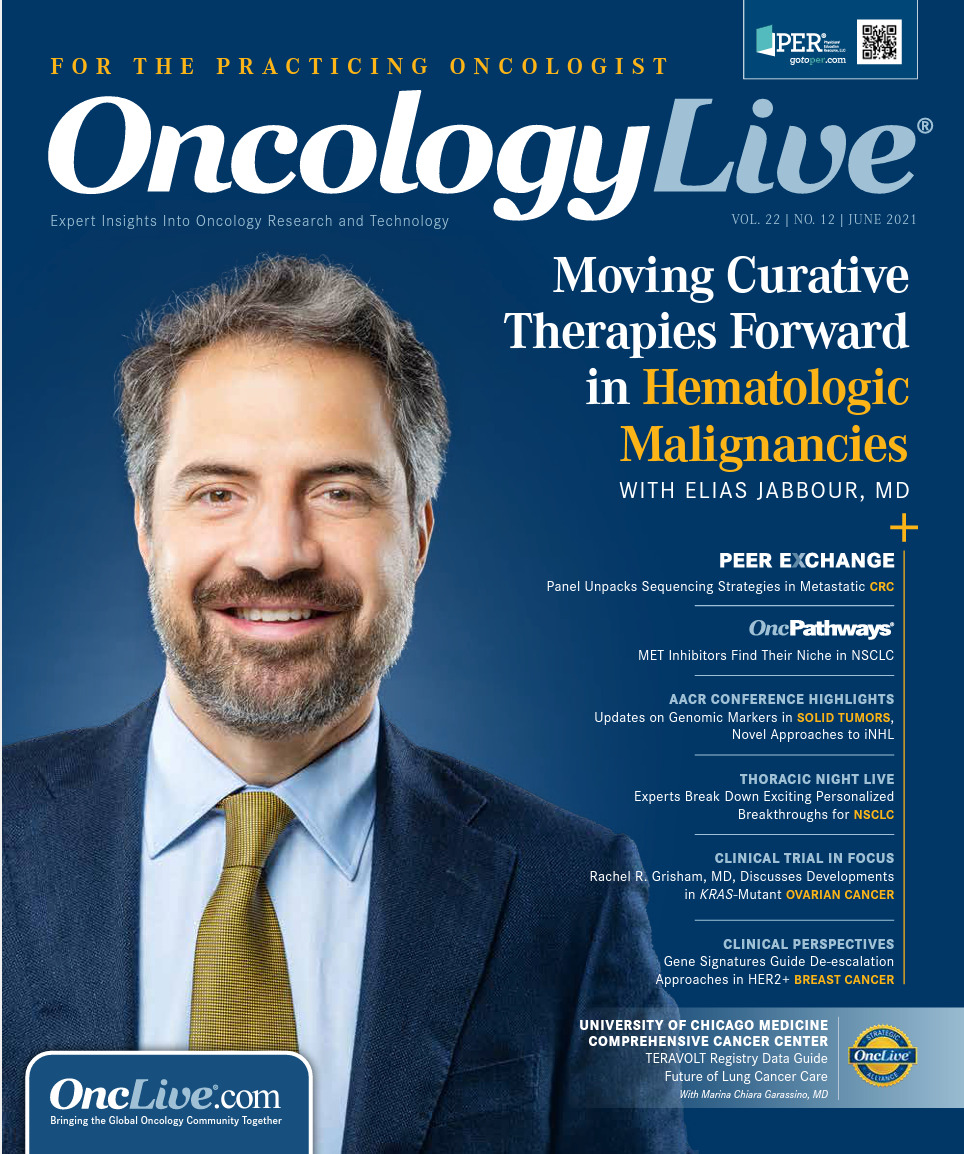Publication
Article
Oncology Live®
Precision Medicine Presents a Disconnect in Oncology Practice
Author(s):
Multiple FDA approvals and an increasing number of clinical trials examining molecular target–based therapeutics, including second- or even third-generation drugs against a well-defined target, present an ever-widening array of drugs for routine cancer care based on the discovery of specific molecular targets within the tumor or within the germline.
Maurie Markman, MD

The precision medicine revolution has become a major component of cancer treatment. Multiple FDA approvals and an increasing number of clinical trials examining molecular target–based therapeutics, including second- or even third-generation drugs against a well-defined target,1 present an ever-widening array of drugs for routine cancer care based on the discovery of specific molecular targets within the tumor (somatic abnormalities) or within the germline.
Further, recent regulatory approvals have been granted for precision medicine–based drug delivery agnostic to the cancer’s site of origin. Reasonable use of the particular antineoplastic requires the documented presence of the specific molecular target. Examples include a level of mutations within tumors cells to suggest the potential benefits of checkpoint inhibitors and the presence of a microsatellite unstable molecular signature to similarly suggest the potential benefits of this class of immunotherapeutic drugs. Whereas the current effect of the precision medicine revolution has been argued by some to be excessively hyped,2 others have provided strong arguments against this conclusion.3
However, the promise of precision medicine at the individual patient and physician level cannot be assumed to follow regulatory decisions. Rather, it falls to the drug manufacturers to market the use of targeted therapeutics in specific clinical settings and to molecular diagnostic companies to advertise approvals of their platforms by the FDA as options for tumor agnostic approaches to disease management.
A potential magnitude of disassociation may exist between clinical trial data, regulatory approval, and medical society or insurance company pathway recommendations for obtaining molecular information essential to deliver a targeted therapeutic and the “real world” of community oncology care in the United States. This was highlighted in a recent report that examined medical records of women with ovarian cancer and the percentage of whom had undergone germline testing for the presence of a BRCA mutation.4 Results of clinical germline testing for patients in Georgia and California were linked with Surveillance, Epidemiology, and End Results data for individuals who received a diagnosis of breast or ovarian cancer from 2013 to 2017. Only 34.3% of 14,689 patients with ovarian cancer had undergone germline testing.4
This rather distressing result occurred despite the fact that multiple national medical organizations and widely accepted medical pathways have, for a number of years, strongly recommended that this information be obtained to evaluate the potential risk of breast and ovarian cancer in family members of patients with a diagnosis of cancer. A low rate of germline testing is also increasingly being seen in patients with prostate and pancreatic cancer. Further, where appropriate, prophylactic surgical procedures (eg, bilateral oophorectomy, mastectomy) have been shown to reduce the risk of subsequent malignancies in BRCA mutation carriers.
Finally, recently reported phase 3 trial results have demonstrated the major benefits associated with the delivery of PARP inhibitors as a maintenance therapy approach in women with ovarian cancer who are BRCA mutation positive. Despite the extensive evidence of the clinical utility associated with obtaining this specific germline (and somatic) mutation data, there is an evident strong disassociation between what is clearly optimal care and the reality of real-world clinical oncology.
A number of possible reasons can be cited for these disquieting results, beginning with the observation that the speed of changes in our understanding of the biology of individual cancers and the corresponding modification in our therapeutic armamentarium continues to rapidly accelerate. This state of affairs makes it increasingly difficult for non–tumor-specific oncology specialists to stay up-to-date with the spectrum of multiple modifications in disease management. The academic oncologist who specializes in understanding the biology and treatment of a single cancer (eg, breast cancer) or group of malignancies (eg, gynecologic cancers) or a member of a large community oncology practice who may have a similar opportunity to focus on a limited set of diseases will almost certainly be in a superior position to deal with these rapidly expanding changes.
However, for the generalist who may routinely be responsible for the care of multiple cancer types in any given day, the ability to keep up with the changes in treatment, particularly new molecularly-based therapeutic options, may be daunting.
Although oncologists will certainly never intentionally deny their patients the best possible care they can provide, the outcome may be the same if they are not aware of new developments, they do not have the time to be regularly updated, or they do not have accessible, robust decision-support tools that may help them apply best practice in a given clinical situation.
When considering the decision to employ a precision medicine approach, it is necessary to highlight the fact this increasingly requires next-generation sequencing rather than a single test of a specific molecular abnormality. There are additional issues to consider with the implementation of this expanded molecular testing strategy.
There are many questions that should be asked. Which testing platform among the many available will be optimal in a given practice? Will insurance pay for such testing? How easy is it to interpret the results reported? What decision-support tools are provided by the company to assist the clinician? How realistically available (eg, geographical location, eligibility criteria) to an individual clinician and patient are clinical trials that may be suggested by the molecular results?
Further complicating the issue of testing is a situation where the results indicate that the off-label use of an existing commercially available antineoplastic could be useful. How does the physician obtain insurance company approval or possible compassionate use of the drug by obtaining it from the manufacturer? If an oncology practice has no or limited experience in this area, the learning curve, as well as time and effort required for an individual agent, can potentially be a significant impediment. Again, it is not the lack of desire by the physician to help the patient but instead objectively pragmatic concerns for how to deal with an often complex and ill-defined bureaucracy.
And if the physician is unsuccessful in securing a potentially promising drug, it is not difficult to imagine the effect of that disappointment on the patient and the patient’s health care team.
References
- Shaw AT, Bauer TM, de Marinis F, et al; CROWN Trial Investigators. First-line lorlatinib or crizotinib in ad-vanced ALK-positive lung cancer. N Engl J Med. 2020;383(21):2018-2029. doi:10.1056/NEJMoa2027187
- Prasad V. Perspective: the precision-oncology illusion. Nature. 2016;537(7619):S63. doi:10.1038/537S63a
- Subbiah V, Kurzrock R. Debunking the delusion that precision oncology is an illusion. Oncologist. 2017;22(8):881-882. doi:10.1634/theoncologist.2017-0040
- Kurian AW, Ward KC, Abrahamse P, et al. Time trends in receipt of germline genetic testing and results for women diagnosed with breast or ovarian cancer. J Clin Oncol. 2021;39(15):1631-1640. doi:10.1200/JCO.20.02785





























%20(2)%201-Recovered-Recovered-Recovered-Recovered-Recovered-Recovered-Recovered-Recovered-Recovered-Recovered-Recovered-Recovered-Recovered-Recovered-Recovered-Recovered-Recovered.jpg?fit=crop&auto=format)
%20(2)%201-Recovered-Recovered-Recovered-Recovered-Recovered-Recovered-Recovered-Recovered-Recovered-Recovered-Recovered-Recovered-Recovered-Recovered-Recovered-Recovered-Recovered.jpg?fit=crop&auto=format)
